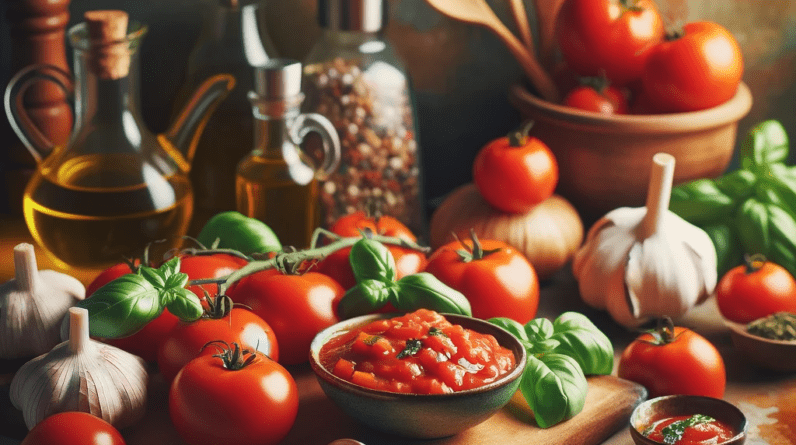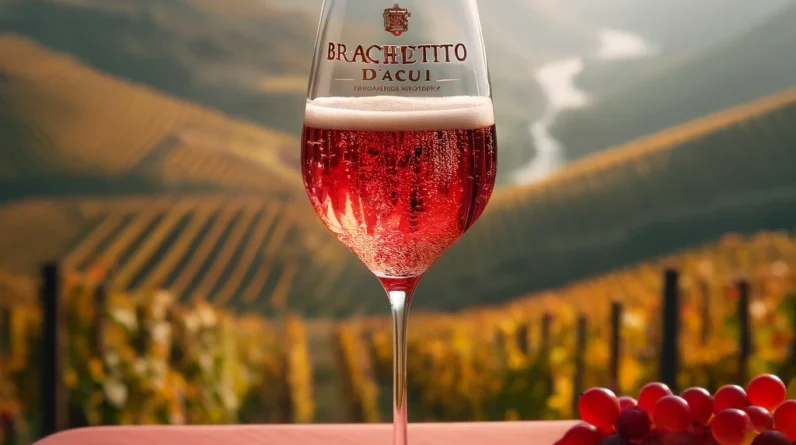
Mastering the Art of Wine Pairing: Sangiovese and Rich Tomato Sauce Dishes
Welcome to the fascinating world of wine and food pairing, where every sip and bite tells a story.
In this guide, we delve deep into why Sangiovese, a distinguished Italian red, is the ideal companion for dishes with rich tomato sauce.
Prepare to embark on a sensory adventure that will elevate your dining experience.

Understanding Sangiovese: The Italian Virtuoso
Origins and Characteristics
Deeply rooted in Italian wine history, Sangiovese is the pride of regions like Tuscany.
Its name, translating to ‘the blood of Jove,’ hints at its revered status.
This medium-bodied wine often presents flavors of cherry, plum, and earthy tones, with hints of oak and spice in aged varieties.
Variations
Sangiovese comes in various styles – from the light and sprightly to the robust and age-worthy.
Chianti, Brunello di Montalcino, and Morellino di Scansano are some notable expressions, each offering a unique twist on the classic Sangiovese profile.

The Tomato Sauce Connection: A Canvas of Flavors
Types of Tomato Sauces
From the simplicity of a Pomodoro to the complexity of a slow-cooked ragù, tomato sauces vary greatly.
Each type brings its acidity, sweetness, and herbal notes, making the choice of wine crucial for harmony.
Culinary Considerations
Consider the ingredients and preparation method.
A sauce with fresh basil or oregano will align differently with wine than one enriched with meat or roasted vegetables.
Why They Work Together: A Symphony of Flavors
Acidic Alignment
Sangiovese’s acidity doesn’t just match the tomato sauce’s tang; it elevates it, creating a vibrant and lively interplay of flavors.
Tannins and Texture
The robust tannins in Sangiovese, especially in aged varieties, are softened by the sauce’s richness, leading to a smoother, more rounded taste experience.
Flavor Enhancements
Herbal and earthy notes in Sangiovese complement common ingredients in tomato sauces like basil, garlic, and thyme, highlighting the depth and complexity of both.

Pairing Tips: A Practical Guide
Young Sangiovese with Light Sauces
Wine Example: A classic example is a young Chianti, known for its bright cherry flavors and lively acidity.
Try: Rocca delle Macìe Chianti Classico 2020 – A vibrant and fresh Sangiovese, showcasing lively cherry and raspberry notes with a hint of spice.
Dish Pairing: Pair this with a simple spaghetti al Pomodoro, where the fresh tomato sauce, seasoned with basil and a hint of garlic, allows the fruity character of the wine to shine.
The acidity in both the wine and the sauce complement each other, creating a refreshing and harmonious dining experience.
Aged Sangiovese with Hearty Sauces
Wine Example: Brunello di Montalcino, with its rich, full-bodied nature and notes of dark fruits and earthy spices, is an excellent choice.
Try: Poggio Antico Brunello di Montalcino 2015 – Known for its rich texture and layers of dark fruit, leather, and tobacco, this Brunello offers a complex flavor profile.
Dish Pairing: Try this wine with a hearty meat-based Bolognese, for example Rigatoni Bolognese.
The complexity and depth of the Brunello can stand up to the robust flavors of the sauce, with its layers of slow-cooked beef or pork, tomatoes, and a mélange of herbs.
The tannins in the wine interact beautifully with the proteins and fats in the meat, smoothing out the wine’s texture and enhancing the overall taste.
Mid-Aged Sangiovese for Versatile Dishes
Wine Example: Morellino di Scansano, which is slightly aged and offers a balance between fruity and earthy notes.
Try: Fattoria Le Pupille Morellino di Scansano 2018 – A beautifully balanced wine, offering a mix of ripe red fruit and subtle earthy notes.
Dish Pairing: Ideal for a tomato sauce with roasted vegetables and herbs, for example Penne Arrabbiata with roasted vegetables.
The medium body of Morellino complements the richness of the sauce while its subtle earthy undertones harmonize with the herbal and roasted flavors of the dish.
This pairing is perfect for those who enjoy a touch of complexity without overpowering the palate.

Additional Tips
Temperature and Serving
Serve the Rocca delle Macìe Chianti Classico slightly chilled to accentuate its freshness.
In contrast, the Poggio Antico Brunello benefits from being served at room temperature to fully express its complex aromas.
Glassware
Use a tulip-shaped glass for the Chianti Classico to concentrate its fruity aromas, and a broader, more open glass for the Brunello and Morellino to allow their layered aromas to unfold.
| Sangiovese Wine | Tomato Sauce Dish |
|---|---|
| Rocca delle Macìe Chianti Classico 2020
| Spaghetti al Pomodoro |
| Poggio Antico Brunello di Montalcino 2015
| Rigatoni Bolognese |
| Fattoria Le Pupille Morellino di Scansano 2018
| Penne Arrabbiata with Roasted Vegetables |
| Antinori Peppoli Chianti Classico
| Margherita Pizza |
| Castello di Ama San Lorenzo Chianti Classico
| Lasagna al Forno |
| Banfi Chianti Classico Riserva
| Veal Parmesan |
| Il Poggione Brunello di Montalcino
| Chicken Cacciatore |
| Ruffino Riserva Ducale Chianti Classico
| Eggplant Parmigiana |
| Caparzo Brunello di Montalcino
| Spaghetti with Meatballs |
| Tenuta di Nozzole Chianti Classico Riserva
| Pasta alla Norma |
| Altesino Brunello di Montalcino Montosoli
| Tomato and Basil Bruschetta |
Pairing Sangiovese with tomato sauce dishes is not just about taste; it’s about creating moments of culinary delight.
This pairing, steeped in Italian tradition, invites you to explore and appreciate the subtleties of flavor and texture.
While this guide offers a roadmap to perfect pairings, personal preference reigns supreme.
Don’t hesitate to experiment and trust your palate. Each bottle of Sangiovese and every tomato sauce dish has its own story – and the best part is discovering how they unfold together.
FAQs:
Q: Can I pair Sangiovese with vegetarian tomato-based dishes?
A: Absolutely! Sangiovese’s versatility makes it a great choice for vegetarian dishes.
Try it with a tomato-based pasta primavera or a rich tomato and eggplant Parmesan.
The wine’s acidity and earthy notes will complement the flavors of the vegetables and tomato sauce.
Q: Is Sangiovese suitable for all types of tomato sauces?
A: Generally, yes. However, the specific type of Sangiovese can make a difference.
Lighter sauces pair well with younger, fruitier Sangioveses, while heavier, meat-based sauces are better with aged, full-bodied varieties.
Q: What if I can’t find the specific wines mentioned in the pairing guide?
A: No worries! The mentioned wines are examples to guide you.
You can find similar Sangiovese wines by looking for key descriptors like ‘fruity and young’ or ‘aged and full-bodied.’
Your local wine shop can also provide recommendations.
Q: How important is the serving temperature for Sangiovese?
A: Quite important. Serving Sangiovese too warm can make it feel flat, while too cold can mute its flavors.
Aim for 16-18°C (60-65°F) for aged varieties and slightly cooler for younger ones.
Q: Can I pair Sangiovese with spicy tomato sauces?
A: Yes, but carefully. A young Sangiovese with its fruity profile can balance moderately spicy sauces.
However, very spicy dishes might clash with the tannins and acidity of the wine.
Q: What are some tips for experimenting with Sangiovese and tomato sauce pairings?
A: Start with the basic principles of pairing – match the weight and intensity of the wine with the dish.
Don’t be afraid to try different combinations, and always trust your palate.
Wine pairing is subjective and part of the fun is discovering what you enjoy.
Q: Are there any non-Italian Sangiovese wines suitable for tomato sauce pairings?
A: Yes, while Italy is the heartland of Sangiovese, other regions like California and Australia produce excellent Sangiovese wines.
These can also pair well with tomato sauce dishes, offering a different, sometimes fruitier, take on this classic grape.
Q: How can I enhance my wine and food pairing experience?
A: Pay attention to the details – the right glassware, serving temperature, and even the ambiance can elevate your pairing experience.
Also, consider the texture and acidity balance between the wine and the dish for a more harmonious experience.

Master the Art of Wine with Vino Cards: Your Ultimate Wine Learning Companion!
🍇 Dive Into the World of Wine – One Card at a Time! 🍷
Whether you’re a budding wine enthusiast or a seasoned connoisseur, our Vino Cards Wine Learning Flashcards are your perfect guide to the vast and delightful world of wines.
🎴 What’s Inside the Deck?
- Detailed Wine Profiles: Each card unveils a new variety, from popular favorites to hidden gems.
- Expert Tasting Notes: Learn to identify key flavors, aromas, and characteristics like a pro.
- Food Pairing Suggestions: Elevate your dining experience with perfect wine-food combinations.
🏡 Ideal for Cozy Evenings or Social Gatherings, these flashcards turn wine learning into a fun and engaging activity. Spread them out at your next dinner party, or curl up for a solo study session – the choice is yours!
🧠 Why Vino Cards?
- Easy and Accessible Learning: Simplified content that’s perfect for beginners yet insightful for experts.
- Interactive and Enjoyable: Transform your wine education into an interactive adventure.
- Build Your Wine Confidence: Impress friends and family with your newfound knowledge.
🍾 Join the Community of Wine Lovers: Vino Cards are more than just flashcards; they’re your ticket to a passionate community of wine enthusiasts.
🎁 The Perfect Gift for Any Wine Lover: Whether it’s for a birthday, holiday, or just because, these flashcards are a thoughtful and unique present.
🔗 Get Your Vino Cards on Amazon
🥂 Raise Your Glass to Learning and Discovery – One Wine at a Time!







